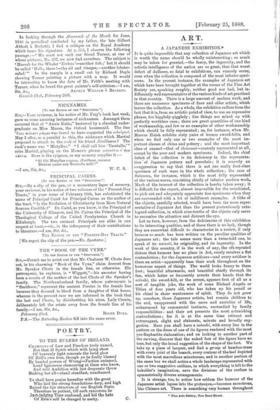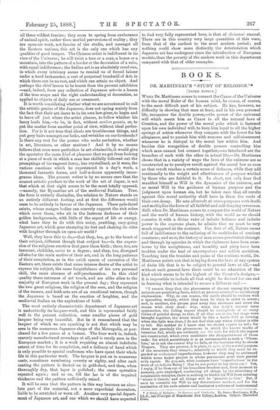ART.
A JAPANESE EXHIBITION.*
IT is quite impossible that any collection of Japanese art which is worth the name should be wholly uninteresting ; so much may be taken for granted,—the fancy, the ingenuity, and the artistic intelligence of the nation are so great, that that worst defect of dullness, so fatal to exhibitions, can scarcely occur, even when the collection is composed of the most inferior speci- mens. In the present instance, the examples of Japanese art which have been brought together at the rooms of the Fine Art Society are, speaking roughly, neither good nor bad, but in- differently well representative of the various kinds of art practised in that country. There is a large amount of modern work, and there are numerous specimens of finer and older artists, which leaven the collection. As a whole, the exhibition suffers from the fact that it is, from an artistic point of view, to use an expressive phrase, too higgledy-piggledy ; fine things are mixed up with perfectly worthless ones ; there are great quantities of one kind of workmanship, and few or no examples of other workmanship which should be fully represented ; as, for instance, when Mr. Marcus Huish exhibits sixty pairs of bronze sword-hilts, and when we find only one or two examples of the most im- portant classes of china and pottery ; and the most important class of enamel—that of cloisonne—scarcely represented at all, except by the poor and modern specimens. Indeed, the chief defect of the collection is its deficiency in the representa- tion of Japanese pottery and porcelain ; it is scarcely an exaggeration to say that there is not one really first-class specimen of such ware in the whole collection ; the case of Satsuma, for instance, which is the most fully represented of the various wares, consisting chiefly of inferior modern work. Much of the interest of the collection is hereby taken away ; it is difficult for the expert, almost impossible for the uninitiated, to pick out and adequately appreciate fine specimens when they are surrounded with a lot of indifferent examples. A tithe of the objects, carefully selected, would have been far more repre- sentative of Japanese Art than the present pretentiously cata- logued collection, in which nine-tenths of the objects only serve to encumber the attention and distract the eye.
Let us turn, however, from the deficiencies of this exhibition to its interesting qualities, and of these there is no lack, though they are somewhat difficult to characterise in a review, if only because so much has been written on the peculiar qualities of Japanese art ; the tale seems more than a twice-told one, to speak of its naivete, its originality, and its ingenuity. In the work of this country, if in the work of any, the oft-repeated dictum that humour has no place in Art, surely receives a flat contradiction ; for the Japanese artificers—and every artificer is there an artist—apparently base their work throughout on the humorous aspect of things. The world looks funny to them first ; beautiful afterwards, and beautiful chiefly through its fun, which latter so frequently arrests their hands that the netsuke, the sword-hilt, or the screen, appears first of all as a sort of tangible joke, the work of some Michael Angelo or Titian of four years old, who has taken up his pencil or his chisel in sheer wantonness of spirit. They do not grow up, somehow, these Japanese artists, but remain children to the end, nnoppressed with the cares and anxieties of life, unharrassed by commercial instincts, unsteadied by family responsibilities : and their art presents the most astonishing contradictions ; for it is at the same time reticent and extravagant, slight and elaborate, minute and broadly sug- gestive. Here you shall have a netsuke, with every line in the pattern on the dress of one of its figures rendered with the most pre-Raphaelite elaboration; and on looking to another part of the carving, discover that the naked feet of the figure have no toes, but only the broad suggestion of the shape of the foot. We take up a piece of lacquer, and find a graup of bamboo-trees with every joint of the branch, every contour of the leaf depicted with the most marvellous minuteness, and in another portion of the same box we shall notice a whole landscape represented with one or two suggestive outlines, in which everything is left to the beholder's imagination, save the divisions of the surface in symmetrically diverse arrangements.
It is strange, too, to notice how seldom the humour of the Japanese artist lapses into the grotesque,—becomes monstrous, like Chinese art. There is something very human throughout
• Fine Arts Society, New Bond Street.
all these wildest fancies ; they seem to spring from exuberance of animal spirit, rather than morbid perversions of reality ; they are open-air work, not fancies of the studio, and amongst all the Eastern nations, this art is the only one which has any qualities of good temper. The Chinese artist is indifferent in its view of the Universe ; he will twist a tree or a man, a house or a mountain, into the pattern of a border or the decoration of a robe, with equal indifference ; the Indian art is an absolutely cruel one, in which every intricacy seems to remind us of forced labour under a hard taskmaster, a sort of perpetual treadmill of Art, in which there can be no rest, and which can attain no object. And perhaps the chief lesson to be learnt from the present exhibition —and, indeed, from any collection of Japanese art—is a lesson of the true scope and the right understanding of decoration, as applied to objects of daily use or ornament.
It is worth considering whether what we are accustomed to call the artistic genius of the Japanese, does not spring mainly from the fact that their art dares to be its own law-giver, to begin and to leave off just where the artist pleases, to follow whither his fancy leads him,—to be, in fact, without arriere pelage, or, to put the matter from another point of view, without ideal perfec- tion. For is it not true that ideals are troublesome things, and put grey hairs amongst our locks, and wrinkles on oar foreheads ? Is there any rest for the person who seeks perfection, whether in art, literature, or other matters ? And it by no means follows that even were perfection in art obtainable, it would give the spectator the same kind of pleasure that we get from looking at a piece of work in which a man has skilfully followed out the promptings of his vagrant fancy, has crystallised, as it were, the various emotions which he experienced in a day's work, a thousand fantastic forms, and half-a-dozen apparently incon- gruous ideas. The present writer is by no means sure that the nearest artistic product to the work of the art of Japan, is not that which at first sight seems to be the most totally opposed, —namely, the Byzantine art of the medimval Italians. True, the form is entirely dissimilar, the relation to Nature stands on an entirely different footing, and at first the difference would seem to be entirely in favour of the Japanese. These pale-faced saints, whose meagre bodies can scarcely support the rich robes which cover them, who sit in the lustrous darkness of their golden backgrounds, with little of the aspect of life or energy, what have they to do with this noisy, prattling, easy-going Japanese art, which goes stamping its feet and shaking its sides with laughter through an open-air world ?
Well, they have this to do,—that they, too, go to the heart of their subject, different though that subject be,—in the expres- sion of the religious emotion that gave them birth ; these, too, are innocent, childlike, naive to a degree ; and they, too, disregard all else for the main motive of their art, and in the long patience of their completion, as in the quick spasm of execution of the Eastern art, there exists that same intense desire of the artist to express his subject, the same forgetfulness of his own personal skill, the same absence of self-proclamation. In this chief quality these extremes of art touch, and are alike alien to the majority of European work in the present day ; they represent the two great religions, the religion of the seen, and the religion of the unseen, and both arts are of an emotional nature, though the Japanese is based on the emotion of laughter, and the medimval Italian on the aspirations of faith.
The most entirely characteristic department of Japanese art is undoubtedly its lacquer-work, and this is represented fairly well in the present collection, some smaller pieces of gold lacquer being very beautiful. But be it remembered that the lacquer of which we are speaking is not that which may be seen in the numerous Japanese shops of the Metropolis, or pur- chased for a few pence at a bazaar. The finer work is, indeed, scarcely manufactured nowadays at all, and is rarely seen in the European market ; it is a work requiring an almost indefinite extent of time for its completion, and a delicacy of hand which is only possible to special craftsmen who have spent their whole life in this particular work. The lacquer is put on in numerous coats, sometimes numbering seventy or eighty, and after each -coating the pattern is dusted on in gold-dust, and then, when thoroughly dry, that layer is polished ; the same operation repeated again ; and so on, till the lac is of the required -thickness and the pattern sufficiently raised.
It will be seen that the pattern in this way becomes an abso- lute part of the material, not a mere superficial decoration,
liable to be scratched or worn off. Another very special depart- ment of Japanese art, and one which we should have expected
to find very fully represented here, is that of cloisonné enamel. There are in this country very large quantities of this ware, from that of the earliest to the most modern period ; and nothing could show more distinctly the deterioration which Japanese art has undergone since the introduction of European models, than the poverty of the modern work in this department compared with that of older examples.







































 Previous page
Previous page